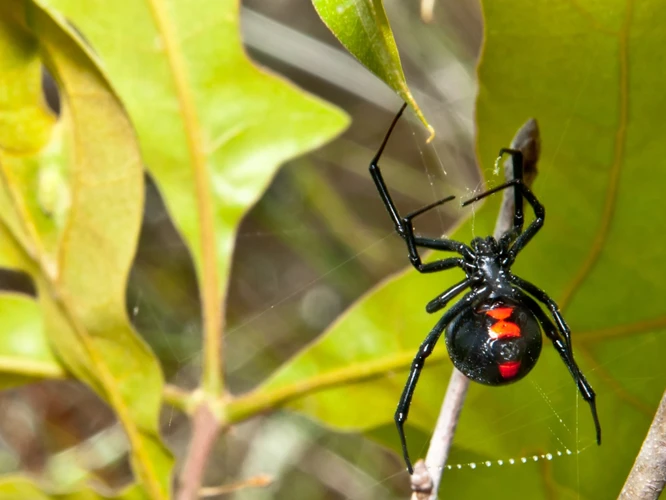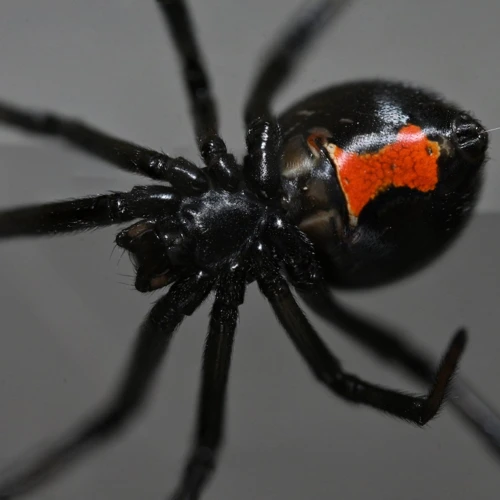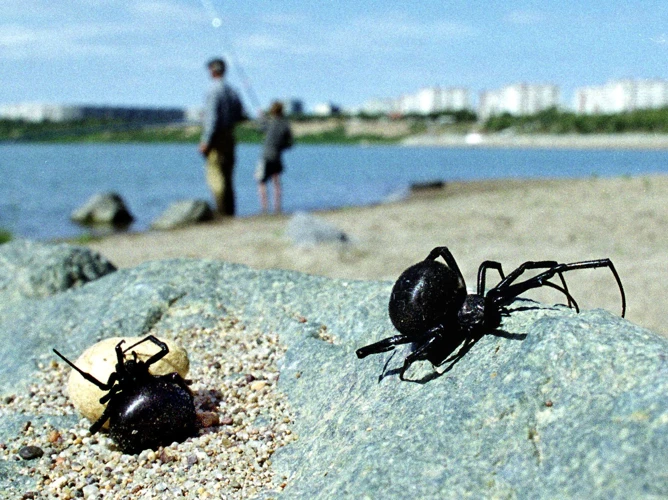As the global climate continues to shift and change, its impact on various species is becoming increasingly apparent. One such species is the black widow spider, known for its unique appearance and venomous bite. With its preference for specific habitats, the black widow is particularly vulnerable to the effects of climate change. In this article, we will explore how rising temperatures, drought, and competition from other species are all affecting the habitat of black widow spiders. Additionally, we will discuss potential changes in behavior and conservation efforts to protect these fascinating creatures as we move towards an uncertain future.
The Basics of Black Widow Habitat

When it comes to the black widow spider, their habitat has a significant impact on their behavior and survival. Understanding their habitat is crucial in predicting how climate change will impact these creatures in the future. The black widow spider is a common inhabitant of many parts of the world, and their habitat ranges from forests to desolate areas. Black widows typically thrive in habitats with complex physical structures, such as woodpiles or attics which provide shelter, security and humidity (source) . In this section, we will delve into the basics of black widow habitat, including their range and their preferences for specific habitats.
Black Widow Range
The black widow spider is one of the most well-known spider species in the world. They are found all across the globe, but primarily in the warm regions of the United States, including the southern states and western regions, such as California. The range of black widow spiders extends from the Sonoran and Mojave deserts, to the Atlantic Ocean, and from the southern part of Canada to South America. Currently, there are five species of black widow spiders found in North America, including the Southern black widow, Northern black widow, Western black widow, Brown widow, and Red widow.
The black widow spiders are known to inhabit a wide range of habitats, from deserts to forests, and even suburban and urban environments. The black widow spiders prefer areas with abundant cover, including rocks, logs, brush piles, and debris. They also tend to prefer habitats with moderate moisture. In some cases, black widow spiders have adapted to human presence and become common in urban areas, such as parks, gardens, and abandoned buildings.
The range of black widow spiders and their habitats are affected by various factors, such as climate change, human activities, and interactions with other species. All of these factors can impact the overall population of black widow spiders and their habitat distribution.
Table below shows the distribution of black widow spider species in North America:
| Species | Range |
|---|---|
| Southern black widow | From New York to Florida and west to California and north to Maine, and the eastern half of the United States. |
| Northern black widow | From south-central Canada into the northern United States, including western Montana, Wyoming, and southern Wisconsin. |
| Western black widow | Western regions of North America such as California, Utah, and Washington. |
| Brown widow | Primarily in southern California and throughout Florida. |
| Red widow | Restricted to central and southern Florida, living in and around palmetto bushes and other vegetation types. |
The northern and southern black widows are the most common species in North America and have the widest distribution. They tend to be found in areas with the most moderate temperatures and rainfall. Meanwhile, the brown widow spider is increasing in numbers due to the ability to tolerate a wider range of climatic conditions and latitude. The Western black widow is found in regions with lower precipitation and temperature, while the Red widow is restricted to central and southern Florida.
As changes in climate continue to impact black widow habitats, the range of these spider species is likely to change as well. Learn more about the impact of changing temperatures and droughts on black widows in the following section.
Habitats They Prefer
Black widows are known to inhabit a wide range of habitats, from forests and deserts to urban areas. They often prefer secluded and sheltered locations, such as woodpiles, under rocks, and in burrows. Additionally, black widows are drawn to areas with ample food sources, such as flies, mosquitoes, and grasshoppers. They can also typically be found near sources of water, such as streams, ponds, or even leaky irrigation systems.
It is important to note that while black widows are generally found in areas with high humidity, they can also survive in more arid environments. They have adapted to these inhospitable areas by seeking out water sources and being able to tolerate dry conditions.
Interestingly, black widow spiders are also known to be attracted to man-made structures. They are often found in garages, sheds, and other structures that provide shelter, as well as in outdoor lighting fixtures. This is because black widows are nocturnal and are attracted to light sources.
While black widows are adaptable and can survive in a variety of habitats, climate change could have a significant impact on their ability to thrive. For example, rising temperatures and drought could impact the availability of water, which would impact their food sources. As a result, they may need to move to new areas in search of more favorable conditions.
They may also face increased competition for resources from other species that are also trying to adapt to changing climates. This could serve to further stress black widow populations and make it harder for them to survive.
The habitats that black widows prefer are varied and depend on a variety of factors. They are adaptable but may struggle to survive in the face of climate change and increased competition from other species. For more information on the impact of climate change on black widows and their habitats, please see the section on ‘The Impact of Climate Change on Black Widows‘.
The Impact of Climate Change on Black Widows

As global temperatures continue to rise, many species are struggling to adapt to the changing climate. Black widow spiders are no exception, as they rely heavily on specific habitats and weather conditions to survive. This has led to a significant impact on their populations and behavior, which can have a ripple effect throughout their ecosystems. Let’s explore the ways in which climate change is affecting black widow habitats and what it means for the future of these fascinating arachnids.
Rising Temperatures and Drought
As the Earth’s climate continues to change, the habitats of black widow spiders are also being affected. Rising temperatures and drought can have a significant impact on these creatures. Here are some ways that these changes can affect black widow habitats:
– Black widow spiders are adapted to live in warm environments, but if temperatures become too extreme, it can become difficult for them to survive. High temperatures can negatively impact their fitness, behavior, and reproductive success.
– Drought can also have a major impact on black widow habitats. These spiders require a reliable source of water to survive, and drought can make it difficult for them to find enough moisture to meet their needs.
– In addition to being affected by the changes in their immediate environment, black widows may also face competition from other species as their habitat shifts due to climate change.
To learn more about how water availability impacts black widow habitats, check out our article on water and black widow spider habitat. In addition to climate change, there are many other human activities that can impact black widow habitats. To learn more, take a look at our article on 16 ways humans impact black widow spider habitats. Understanding what attracts black widows to certain habitats can also be helpful in predicting how they will fair in the face of changing environmental conditions. For more information, take a look at our article on what attracts black widows to certain environments.
Moving Habitats
Climate change is causing a significant impact on Black Widows, leading to various challenges. One of the biggest problems they face is the need to move to new habitats. As the temperature increases, they may find it difficult to survive in their old environments, forcing them to search for new habitats that meet their needs.
Why are Black Widow spiders moving habitats?
Rising temperatures are making the spiders feel less comfortable in their current habitats, affecting their survival rates. As the temperature changes, their prey, preferred shelter, and daily activities are also being affected. They are shifting towards habitats like tall grasslands or even urban areas, where it is a bit cooler and where they can find shelter and food with ease.
When are they moving?
Due to the gradual process of climate change, Black Widow spiders are moving slowly. They tend to move as soon as they start experiencing changes in their habitats. With time, the search for suitable environments may become more urgent as the unsuitable environments become increasingly uninhabitable.
What factors are they looking for in a new habitat?
While searching for new habitats, Black Widows prioritize factors like shelter options and availability of prey. They are also likely to consider the presence of other predators, the level of moisture, and the amount of sun exposure in the new habitat. Once they settle on a new habitat, they re-establish their ecological niche and start hunting their preferred prey.
The changes Black Widows will have to adapt to in the coming years will be quite challenging, but these creatures have been able to evolve and adapt throughout history. It’s worth noting that restoring ecosystems and minimizing the impacts of climate change is the best way to ensure the survival of Black Widows, which, in turn, benefits other species.
Temperature changes contribute significantly to the movement of these spiders. However, there are several other factors to consider when discussing the causes and effects of climate change on Black Widow spider habitats.
Competition from Other Species
Climate change not only affects the weather but also impacts the likelihood of competition among animals. In the case of black widow spiders, competition from other species can be fatal to their survival. As temperature increases due to global warming, many species are moving to different habitats and territories, leading to increased competition for resources.
According to a study, black widows have been found to be in direct competition with red widow spiders, which are larger and more aggressive than black widows. The red widow spider preys on other species of spiders, including the black widow, leading to depletion of the black widow population.
Another species that competes with black widows is the brown widow spider, which is gradually moving into the black widow’s territory. Brown widows are more efficient predators and can easily outcompete black widows for food and shelter. This competition can even lead to the disappearance of black widows from their habitats over time.
As mentioned earlier, black widows are known to require specific ecological niches to survive. If the competition from other species intensifies, then black widows may be forced to move to new habitats where they encounter entirely new conditions and may risk extinction.
To summarize, competition from other species is a crucial factor affecting the survival of black widow spiders. They are not only affected by climate change but also by the movement of other species into their habitats. A better understanding of the interactions between species will help conservationists to develop and implement effective strategies to protect black widows and their habitat.
Looking to the Future
As climate change continues to take a toll on our planet, it’s important to consider how it will affect all creatures great and small. This is especially true for the black widow spider, whose habitats have already been impacted by rising temperatures and changing weather patterns. But what does the future hold for these venomous arachnids? Let’s take a closer look at potential changes in behavior and conservation efforts to protect their ecological niche.
How Black Widow Behavior May Change
As climate change continues to impact the habitats of black widow spiders, their behavior may change in various ways. According to research studies, black widows may respond to rising temperatures and drought by changing their activity patterns and feeding behavior.
Activity Patterns: Black widows are primarily nocturnal, but as temperatures rise, they may become more active during the daytime to avoid extreme heat. This change in activity pattern could lead to increased encounters with humans, which may not bode well for either species.
Feeding Behavior: Black widows prey on insects, and as climate change affects insect populations, these spiders may need to adapt their feeding behavior to survive. One possible change could be an increased use of cannibalism, where females consume the males after mating, as other prey options become scarce.
In addition to these behavioral changes, black widows may also be impacted by changes in the light levels in their habitats. Research suggests that artificial light at night can disrupt the activity patterns of black widows, leading to changes in their behavior and possibly affecting their survival. This is important to consider in conservation efforts for the species.
It’s important to note that predicting how black widow behavior will change in response to climate change is complicated, and more research is needed to fully understand the issue. However, understanding the potential changes in behavior can help inform conservation efforts and ecological management strategies to protect black widow populations and their ecological niche.
For more information on black widow spiders and their habitats, check out our article on the habitat preferences of black widows, or read about the impact of light on black widow behavior in our previous research.
Possible Conservation Efforts
Possible Conservation Efforts
Conservation efforts aimed at preserving the ecological niche of black widow spiders could help ensure their long-term survival. Here are some potential conservation measures that could be taken:
| Conservation Measure | Description |
|---|---|
| Protecting natural habitat | Preventing destruction of the natural habitats where black widows live can help ensure that they can continue to thrive. |
| Reducing greenhouse gas emissions | Efforts to curb carbon emissions can help reduce the effects of climate change, which is a major threat to black widow spiders. |
| Controlling invasive species | Invasive species can displace black widow spiders from their natural habitats, so controlling the spread of these species is vital to the spiders’ survival. |
| Conservation education and outreach | Increased public awareness about the importance of conserving biodiversity can help promote policies and initiatives aimed at protecting black widow spiders. |
Implementing these conservation measures will require widespread cooperation among government agencies, conservation organizations, and the general public. However, such efforts are crucial for ensuring the long-term survival of black widow spiders and the ecological systems they inhabit.
Conclusion
In conclusion, it’s clear that climate change is having a significant impact on the habitats of black widow spiders. The rising temperatures and drought brought about by climate change are forcing black widows to seek out alternative habitats or adapt to the changing environment. Additionally, competition from other species is displacing black widows from their preferred environments, making it difficult for them to find suitable homes.
Looking to the future, it’s important to consider how black widow behavior may change as a result of these changes to their habitats. It’s possible that we may see alterations in their mating and hunting behaviors or changes to the size and number of their populations. Conservation efforts will also be crucial in preserving and protecting these important spider species.
Possible conservation efforts could include habitat restoration and the protection of natural black widow habitats. Programs aimed at educating the public about the importance of black widow spiders and their role in the ecosystem could also help to raise awareness and promote population growth for these spiders.
In all, while the impact of climate change on black widows is concerning and requires careful attention, there is still hope for the future of these important spider species. Through a combination of research, education, and conservation efforts, we can work to ensure that black widow habitats remain intact and that these fascinating spiders continue to thrive in the years to come.
Frequently Asked Questions
What is the life expectancy of a black widow?
Female black widows typically live 1-3 years in the wild while males only live a few months.
How can I tell if there are black widows in my area?
You can look for the distinct black and red hourglass shape on their abdomen or search for their messy webs in protected areas.
What happens if I am bitten by a black widow?
Bites can cause muscle pain and spasms, cramps, and other serious symptoms. Seek medical attention immediately if bitten.
How does climate change affect black widow spider habitats?
Climate change can lead to drought and rising temperatures, which can impact the availability of food and resources in their habitats.
What do black widow spiders eat?
They primarily feed on insects such as flies, mosquitoes, and grasshoppers.
Can black widows move to new habitats?
Yes, they can move to new habitats if conditions become unfavorable or if they are forced out by other species.
What are some potential conservation efforts for black widow spiders?
Protecting their habitats through conservation efforts and reducing human impact on the environment may help preserve their populations.
How can I safely remove a black widow spider from my home?
You should contact a pest control professional to handle the removal of black widow spiders from your home.
Do male black widows pose a threat to humans?
No, males do not have the ability to inject venom and are not considered dangerous to humans.
Can black widows be found in urban areas?
Yes, they can be found in urban areas such as garages, sheds, and woodpiles due to the abundance of insects to feed on.






